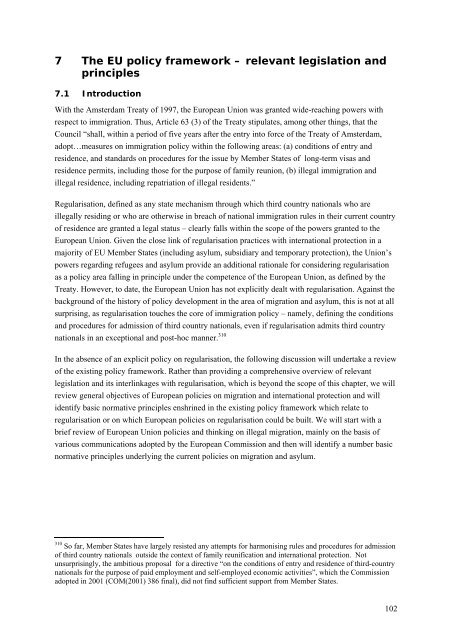REGINE Regularisations in Europe Final Report - European ...
REGINE Regularisations in Europe Final Report - European ...
REGINE Regularisations in Europe Final Report - European ...
Create successful ePaper yourself
Turn your PDF publications into a flip-book with our unique Google optimized e-Paper software.
7 The EU policy framework – relevant legislation and<br />
pr<strong>in</strong>ciples<br />
7.1 Introduction<br />
With the Amsterdam Treaty of 1997, the <strong>Europe</strong>an Union was granted wide-reach<strong>in</strong>g powers with<br />
respect to immigration. Thus, Article 63 (3) of the Treaty stipulates, among other th<strong>in</strong>gs, that the<br />
Council “shall, with<strong>in</strong> a period of five years after the entry <strong>in</strong>to force of the Treaty of Amsterdam,<br />
adopt…measures on immigration policy with<strong>in</strong> the follow<strong>in</strong>g areas: (a) conditions of entry and<br />
residence, and standards on procedures for the issue by Member States of long-term visas and<br />
residence permits, <strong>in</strong>clud<strong>in</strong>g those for the purpose of family reunion, (b) illegal immigration and<br />
illegal residence, <strong>in</strong>clud<strong>in</strong>g repatriation of illegal residents.”<br />
Regularisation, def<strong>in</strong>ed as any state mechanism through which third country nationals who are<br />
illegally resid<strong>in</strong>g or who are otherwise <strong>in</strong> breach of national immigration rules <strong>in</strong> their current country<br />
of residence are granted a legal status – clearly falls with<strong>in</strong> the scope of the powers granted to the<br />
<strong>Europe</strong>an Union. Given the close l<strong>in</strong>k of regularisation practices with <strong>in</strong>ternational protection <strong>in</strong> a<br />
majority of EU Member States (<strong>in</strong>clud<strong>in</strong>g asylum, subsidiary and temporary protection), the Union’s<br />
powers regard<strong>in</strong>g refugees and asylum provide an additional rationale for consider<strong>in</strong>g regularisation<br />
as a policy area fall<strong>in</strong>g <strong>in</strong> pr<strong>in</strong>ciple under the competence of the <strong>Europe</strong>an Union, as def<strong>in</strong>ed by the<br />
Treaty. However, to date, the <strong>Europe</strong>an Union has not explicitly dealt with regularisation. Aga<strong>in</strong>st the<br />
background of the history of policy development <strong>in</strong> the area of migration and asylum, this is not at all<br />
surpris<strong>in</strong>g, as regularisation touches the core of immigration policy – namely, def<strong>in</strong><strong>in</strong>g the conditions<br />
and procedures for admission of third country nationals, even if regularisation admits third country<br />
nationals <strong>in</strong> an exceptional and post-hoc manner. 310<br />
In the absence of an explicit policy on regularisation, the follow<strong>in</strong>g discussion will undertake a review<br />
of the exist<strong>in</strong>g policy framework. Rather than provid<strong>in</strong>g a comprehensive overview of relevant<br />
legislation and its <strong>in</strong>terl<strong>in</strong>kages with regularisation, which is beyond the scope of this chapter, we will<br />
review general objectives of <strong>Europe</strong>an policies on migration and <strong>in</strong>ternational protection and will<br />
identify basic normative pr<strong>in</strong>ciples enshr<strong>in</strong>ed <strong>in</strong> the exist<strong>in</strong>g policy framework which relate to<br />
regularisation or on which <strong>Europe</strong>an policies on regularisation could be built. We will start with a<br />
brief review of <strong>Europe</strong>an Union policies and th<strong>in</strong>k<strong>in</strong>g on illegal migration, ma<strong>in</strong>ly on the basis of<br />
various communications adopted by the <strong>Europe</strong>an Commission and then will identify a number basic<br />
normative pr<strong>in</strong>ciples underly<strong>in</strong>g the current policies on migration and asylum.<br />
310 So far, Member States have largely resisted any attempts for harmonis<strong>in</strong>g rules and procedures for admission<br />
of third country nationals outside the context of family reunification and <strong>in</strong>ternational protection. Not<br />
unsurpris<strong>in</strong>gly, the ambitious proposal for a directive “on the conditions of entry and residence of third-country<br />
nationals for the purpose of paid employment and self-employed economic activities”, which the Commission<br />
adopted <strong>in</strong> 2001 (COM(2001) 386 f<strong>in</strong>al), did not f<strong>in</strong>d sufficient support from Member States.<br />
102
















